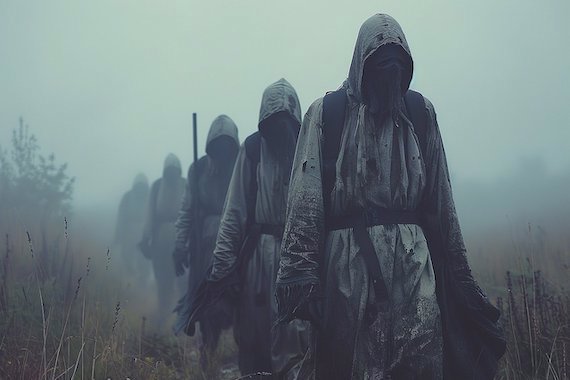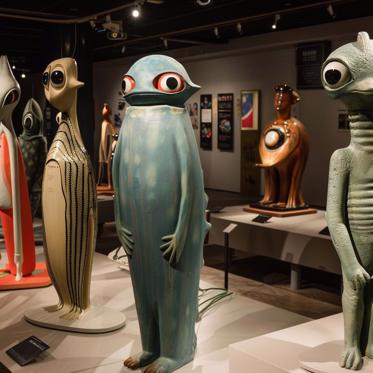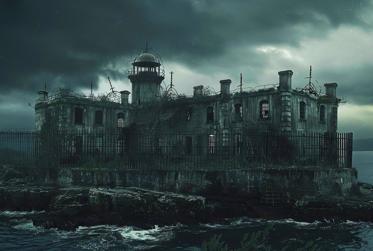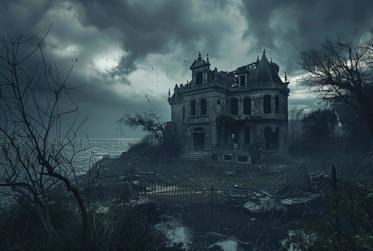The world sometimes seems to be populated with supposedly haunted places, and this so far has been a series on the various haunted islands of the world. Here we will look again at this phenomenon, including haunted island paradises, cursed ruins, a Native American island of death, and a fairy-infested haunted island steeped in myth and legend.
One of the most haunted islands in the world also happens to be among the most picturesque. The Okinawa islands of Japan are among some of the most postcard-perfect locales in the nation, sporting pristine white sand beaches, azure waters, and looking very much the part of an island paradise. One might forget while taking in the fun in the sun that this was also the location of one of the bloodiest, intense battles of the Second World War, and indeed it is a land still haunted by this past, perhaps quite literally. Among the many places that are said to be prowled by ghosts throughout the islands is one that stands out tall among them as one of the most well-known ghost infested locales in Okinawa, a military base called Kadena Air Base, which is ground zero for all manner of strange and supernatural phenomena.
Probably one of the most notoriously and intensely supposed haunted places on the base was once a modest, unassuming housing unit nestled within the residential area and simply called Building 2283, a very nondescript abode which nevertheless was said to be both haunted and cursed. This particular building had supposedly been wrapped up in a dark, sinister history for as long as it had been around, with the most pervasive tale being that in the 1970s an Air Force officer lost his mind and murdered his whole family there, the base itself accused of covering the tragedy up and quickly moving another family in. This would apparently not work out very well for them, as there was allegedly a string of similar horrific tragedies befalling anyone who lived there, such as another officer who experienced intense hallucinations, paranoia, and violent urges while living there before attacking his family with a knife, killing his own stepdaughter. Another officer is said to have beaten his wife to death while living at the ominous building. Even people just walking by the residence began to report hearing strange noises and being beset with heavy feelings of desolation and dread in its vicinity, as well as sharp headaches and nose bleeds out of nowhere, and rumors of the cursed housing unit spread quickly.

Eventually, the base closed Building 2283 down and turned it into a storage unit, but this seems to have done little to stop the strange phenomena orbiting it. The sounds of weeping and shouting were often reported as emanating from within the darkened, abandoned structure, and a recurring phenomenon was that of the sound of laughing children. Indeed, base children playing on the other side of the fence at the daycare center next door supposedly would hear the voices of ghostly children asking if they could join them or telling them to throw their toys over the fence. Apparitions lurking about the premises were not uncommon either, with one of the most widely seen of these being a spectral woman washing her hair, thought to be the ghost of one of the murder victims. The curtains were also said to open or close on their own, the lights to turn on or off without explanation, a phone to ring from somewhere within, and in one report the whole house was seen to be glowing. Those who dared to venture into the house would say that it was always frigid, even in the middle of the sweltering Okinawan summer, that bloodstains would appear and disappear on the walls and furniture, and that there was a distinct and heavy feeling of a “presence” there watching them from the shadows.
One author who has written of the haunted Kadena Base is Jayne Hitchcock, who wrote about the residence in her 1995 book The Ghosts of Okinawa. Hitchcock claims that she once entered the uninhabited building to conduct a séance, which would yield some rather spooky results. She says that she was able to make contact with two spirit children and that every time she asked them a yes or no question the candle she had set up would jump to the left or the right. This was eerie enough for her that she left with haste and never went into the house again.
In 2009, the notorious Building 2283 was finally demolished, and even this has its share of scary tales, with demolition workers reportedly frequently calling in sick with mysterious illnesses and plagued with headaches, hallucinations, and myriad freak workplace accidents as if something in there did not want the house torn down and was actively working against it. As to why the house might have been so infused with negative energy, locals have said that it probably had been built on some ancient forgotten burial site, but Building 2283 no longer stands, and since base officials are very tight-lipped about the residence it is quite likely we will never know how much truth any of it has or what was going on at that accursed housing unit.
If it was haunted it was apparently not the only haunted house on the base, as a commenter on Reddit attests. The witness says that he lived at Kadena from 2002 to 2005 as a child with his family, at a residence at 72 Clark Vista, of which he says in no uncertain terms, “There's no other way to say this, the house was fucking haunted.” The witness explains:
The paranormal experience I want to share with you happened in my bedroom. In my bedroom was a mirror in which I could see myself if I faced a certain way. As I was trying to go to bed one night I suddenly felt like something was watching me and at that moment I felt an incredible amount of fear. My heart was beating out of my chest and with a quick glimpse into the mirror as I was laying on the bed was a tall shadowy figure in the shape of a man. But this man had no face and it was standing directly over me. The shadowy figure wasn't a solid human shape, but rather looked like it had an all-black robe on with wisps of black smoke coming from its body. The moment I saw the figure I was frozen with fear, but I managed to put a blanket over my head. I stayed under the sheets for what seemed like forever, and mustered up the courage to peek into the mirror to see if the shadowy figure was still looking at me.I lifted up the sheet and with one eye peeked into the mirror and in the mirror I saw the figure even closer to me than before!
Again I retreated to under the sheets. After a few minutes of staying absolutely still, I started to hear ..knock..knock..knock from my closet door. Once that happened I said fuck it and sprinted to my parents’ bedroom and jumped into their bed. I was in 8th grade and my dad was in the army, so his reaction was a little bit of "what the hell are you doing". He told me to go back to my room and I absolutely refused. My mom had believed me and showed me some pity and allowed me to sleep in their bed that night. My dad was stationed back to the states about 2 months later, but I will never forget that night.

Another haunted location on the base is Kadena’s Banyan Tree golf course, which once served as a Japanese field hospital during World War II. According to the lore of the eerie place, it was full of death and suffering, and in addition to all of those who died of their injuries here, there were 17 nurses who fled to commit suicide at the nearby cave when the American forces invaded and took over the hospital. Besides various apparitions of ghostly Japanese soldiers marching about the green expanses of the golf course, the cave itself is said to issue forth groans and screams, with very few brave enough to try and venture into the gloom. The golf course is supposedly also one of the favorite haunts of a spectral samurai, who is also seen at other locations all over the base and is thought to be the restless spirit of a warrior interred at a nearby tomb brushing up against the base.
There is also an old guard gate at the base that seems to be home to a ghostly Marine in a WWII military uniform, sometimes described as covered in blood, who will sometimes actually approach base personnel to ask for a cigarette or a light before vanishing into thin air. This ghost apparently appeared so frequently that some personnel refused to work at the gate, and it has since been closed, although whether this was because of the ghost or some other reason is anyone’s guess and the base isn’t saying. Interestingly, there are similar stories of ghost soldiers asking for cigarettes or lights at other American bases around Okinawa. Is it all just an urban legend or is there something more to it? Who knows?
There are other miscellaneous paranormal sightings around the base as well, such as an account given on the site Ghosts and Stories, by a witness calling himself Dustin, who moved there in 2004 with his wife and lived there for 4 years without anything strange going on. That is, until one evening when they were taking a stroll down to a nearby place called the Olympic shopette, a route that took them through a tree line of Jungle for about 50 feet. He says of his frightening brush with the supernatural:
We usually like to walk at night because of the cool breeze. Occasionally you would see the Okinawan bats flapping around at night and hear them screeching. This never bothered us. Tonight was a different story. My hands are still shaking while writing this on the keyboard. We are very afraid of what we just saw. We walked over to the shopette around 9:00 p.m. like we normally do. On the way back, we were walking next to the Jungle treeline and something caught our eye. We thought a person was standing there in the brush. We looked and sure enough it was. We figured it was a local maybe farming some land out in the jungle. We got to looking and the person was not moving. We pushed the stroller closer and realized it was an apparition. There was an old Okinawan man in a Straw Hat with drooping jowls staring at us blankly, not moving. Only... this is hard to say... he had no body. It was just shadowy mass. The jungle was right behind him. My wife and I just stared in disbelief of what we were seeing. His head then faded away. He did not just back into the jungle, the head just disappeared. Right then and there! It faded. We ran home pushing the stroller as fast as we could and locked the door behind us. My wife is still shaken from it. We never believed in ghosts. Now I see why this place has a reputation for being haunted. I am now a believer in the afterlife. I will never walk past that spot again.
The base is such a hive of intense paranormal activity that it has seemingly spilled over to the surroundings, and there are some neighboring places that are purportedly haunted as well. One is an apartment complex just north of the base off of Highway 58, the lower floors of which were once a department store. This store supposedly went out of business because of persistent sightings of spectral children bloodied and bound in bandages, and the ghostly activity is so intense on the 4th floor that apparently no one will live there. The ghosts might come from an old abandoned hospital sitting next to it, which is also haunted, the ghosts of injured people visible at times through the dust-covered windows. Many of the roads around the base are often said to be frequented by phantoms and wraiths, very often described as looking like WWII-era Japanese soldiers or American GIs, and which wander along in the dark to vanish in front of startled motorists.

It is interesting to think about why this one place might be so intensely haunted. What is it about this base that draws these forces to it? It is the violent past of the area or something else? Unfortunately, the base personnel don't like to talk about these things, and questions about it are mostly met with silence, making it seem like there is either a conspiracy to cover up the phenomena or that there is perhaps a bit of urban legend making going on in this faraway land full of folklore and superstition. Whatever the case may be, it certainly gives one something to think about, and Kadena Air Base remains one of the most well-known haunted locales in Okinawa.
Okinawa holds other haunted places as well. One such place is an ambitious forgotten hotel project in Japan, which unfortunately was carried out on sacred burial grounds and has gone on to become one of the most haunted and supposedly cursed sites in the country. It was supposed to be a dream resort by the sea, a stunning seaside paradise on the Japanese island of Okinawa, that would draw in visitors from all over the world. The Nakagusuku Hotel also variously known by other names such as the Nakagusuku Shiroato Kogen, Hotel Leisure Land, Royal Hotel, or Takahara or Kogen Hotel, was the brainchild of a successful businessman and politician from the Okinawa capital of Naha by the name of Hajime Takara and was envisioned as being a magnificent resort to take advantage of the influx of tourists during the 1975 Okinawa Ocean Exposition, which itself was to celebrate the return of the Ryukyu Island chain to Japan from the United States. In the early 1970s construction began on the sprawling hotel resort, which was to sit in the hills of Kitanakagusuku, Okinawa, with panoramic ocean views of both the Pacific Ocean and East China Sea and just a stone’s throw away from the picturesque and historic Nakagusuku Castle. No expense was to be spared in its elaborate construction, with the resort planned to feature a fully functioning zoo complete with giraffes and elephants, an amusement park, a waterpark, a nightclub, and all of the amenities one would expect from what was to be a playground for rich tourists. However, dark days were ahead for this island fantasy, and the resort was doomed to become known as one of the most cursed and haunted places in Japan.
The problems can perhaps be traced to back before construction even began, when concerned monks in the area came to Takara to plead with him to abandon plans to develop the site. They explained that the proposed hotel resort was to be built over land that held graves, sacred sites, and for good measure what they called a cave inhabited by restless spirits, and that the construction would desecrate this site and upset the spirits. The nearby castle was also the site of many battles and much bloodshed throughout its history, with many of the lords of the castle buried in tombs on the site. Although the governor of Okinawa had moved these graves in the mid-20th century, it was said that many of the bodies actually remained and that to build on the site would be a sacrilege. All of this spooky talk of sacred sites and restless spirits was certainly interesting lore, but this was a wealthy businessman and so he wisely decided to listen to the superstitious monks and halt his plans. Just kidding, of course, construction began right as scheduled, but it would not be long at all before it turned out that the monks might have been right all along.

Almost immediately, construction was beset with problems. Bad weather and poor road conditions were bad enough, but then there were all of the accidents. Workers began experiencing all manner of freak accidents, mishaps, and malfunctions. Equipment would stop working, secured materials would break free to cause danger to those around it, vehicles would crash or stall, workers would be injured in strange accidents, and there were countless other freak occurrences that served to hamper the project and cause costs to balloon. Some workers also began to complain of seeing shadow figures lurking about the site as if somberly watching them, and there were even sightings of an apparition that appeared as a 15th-century lord.
As the accidents and mishaps continued, the project was increasingly seen as cursed and haunted, with some of the workers refusing to come in to work. This is where the story takes a bit of a swerve into possible urban legend, but it is said that one day the businessman in charge of it all decided enough was enough. Tired of workers not coming in because of stories of supernatural forces, Takara allegedly decided to spend the night in the unfinished structure to prove that there was nothing to worry about. According to this version of events, Takara spent the night as promised, but the next day he was found to have gone stark-raving mad and was subsequently committed to an insane asylum.
Whether this place was ever haunted and cursed or not, the project was never seen to completion, as construction was halted in 1975 due to the bankruptcy of the contractor. No one ever picked the project up again, and so the uncompleted hotel would sit there to be slowly reclaimed by the surrounding forest and become a popular abandoned spot for urban explorers, many of whom would bring back all sorts of strange tales. Among the various reports of paranormal phenomena are glowing orbs, shadow figures, apparitions in 15th-century Japanese garb, eyes glowing in the shadows of the ruins, sudden feelings of terror or panic, and even people claiming to have been assaulted by unseen hands. One urban explorer has written of his experiences at the ruins on the site mentalspark:
Inside one building you can see the zoo area where animals were supposed to go. Old artwork grabs at you. Nearby is a staircase leading to a lower level. A level unexplainable, hidden in darkness. Something lives under that staircase. Two separate incidents of viewing “yellow, intense eyes surrounded by darkness” have been reported during my time there. One man was assaulted by something under the stairs. It shook him to the core. He never went back. I never saw those eyes. But I do know others have seen it.
Within is the remains is a well. Cold air and moisture cling to this area. One can feel the temperature drop within 50 feet of the well. I could feel something swirling around me once I entered the lower stairs area. Around the ruins, several homeless and insane men and women still live. One night while travelling down an alley I was assaulted by someone or something throwing heavy bricks. They landed near us scaring us off. We ran.
Strange music and voices can be heard on the winds. Another time visiting the area between the castle and the hotel ruins, a strange reed flute could be heard lilting on the wind. One time the sound came close to us. It was just four of us. We wanted to look around at a new spot. We talked as friends and we heard the strange melody in the background. Once we stopped talking it stopped. A second time it happened. Then the music kept playing and playing. It chilled us to the core. We ran as fast as we could back to the car.
Today it is nothing but weed-choked, feral ruins, defiled by copious graffiti, a crumbling, long forgotten place by all but those who are curious about what is going on here. There have long been efforts to get the place demolished, and indeed the process has already begun, meaning this place will soon disappear into the ether of historical mysteries. What happened here and why are these forces gathered to this doomed project? Is there anything to this all, or is it nothing more than urban legend? The place and ruins are certainly real, but what of the spooky stories? We may never know, and it is all a testament to how such eerie abandoned places have a way of bringing on the odd.

Is there a point when a place can be so saturated with suffering and violence that this anguish somehow possesses it with images, impressions, and textures gleaned from an evil past that have permeated a place to the point where these become palpable textures within our reality, like images of light imprinted onto film or voices on a tape? I have often pondered this when looking at locations of ruthless history that have, for whatever reasons, become inextricably linked to weirdness and the unexplained. Are human folklore and superstition more than enough to make this so, or are there some forces that we have yet to understand allowing blackened, vile history to make its mark upon our world, allowing these atrocities to come back and haunt us as surely as the image of a dead loved one can? If there are such places in this world, then a small, rocky slash of an island in Canada certainly seems like it could be one of them. With a history stained with blood and its trees and land well acquainted with human suffering, blood, and perhaps the screams of the doomed, it is an eerie place that seems as if it could be host to such flickers of the past. Or maybe just plain ghosts. Perhaps both, or maybe nothing at all.
Just to the south of Stanley Park, of Vancouver, British Colombia, standing within Coal Harbor, is a small, picturesque island that seems rather inconspicuous for the most part, with most visitors to the popular nearby Stanley Park hardly even realizing it is there. Other than the Canadian naval base which now sits on the island and its rather quaint atmosphere, there is not much that really stands out about this little speck of land, yet under this calm veneer lurks a dark and violent past that stretches back past European settlement, to when the Native people first inhabited the area, and who called the island simply “Island,” but which would later earn its more sinister title of “Deadman’s Island” through a dark sequence of events.
The land was first tainted with the blood of the dead when two tribes of the area, the Northern and Southern Salish nations, were locked into a bloody war. During one particularly brutal engagement, the southern tribe kidnapped 200 women, children, and elderly tribespeople from their enemies and held them captive on the island, demanding 200 of their enemy’s warriors in exchange for their release. When the northern tribe agreed and handed over 200 of its finest warriors, the men were ruthlessly massacred right then and there by a rain of arrows and knives. According to Native legends, the following day there were mysterious and menacing flaming flowers growing where the dead had fallen, causing the southern tribe to abandon the land and deem it an accursed place plagued with black magic. Author E. Pauline Johnson gave the best account of this bloody massacre in her 1911 book Legends of Vancouver, and described these flowers thus:
In the morning the southern tribes found the spot where they fell people filled with flaming fire-flowers. Dread terror seized upon them. In the depths of the undergrowth on Deadman’s Island there blossomed a flower of flaming beauty… but somewhere down in the sanctuary of its petals pulsed the heart’s blood of many and valiant men.
From that point, the island was known as Deadman’s Island, a name it officially retains today, and the Native peoples of the area saw it as a forsaken land of the dead, fit only as a burial ground for more corpses to join the ones that where already there. The Squamish people took to using the island as a burial ground, usually placing bodies within cedar coffins which they then lodged up within the branches of ancient trees. These coffins would make for a morbid discovery years later, when one of the first white settlers of the area, a man by the name of John Morton, visited the island in 1862. There he found hundreds of the deteriorated, crumbling boxes hanging from the trees like macabre ornaments, with some of them having fallen from the binds which had precariously lashed them to the branches, and been dashed upon the ground to spill their contents of bones, skulls, and tangles of hair upon the soggy ground. Supposedly, one of these boxes disintegrated on touch, showering the horrified Morton with human remains. Indeed it seemed the island lived up to its namesake. These wooden boxes were later moved by the European settlers, who were disturbed by such customs and brought to the nearby graveyard of Lumberman's Arch, where they were buried below ground in keeping with the traditions of the white settlers.

Despite the removal of the burial coffins, Deadman’s Island would remain a place where only the dead went, and it retained its purpose as a burial ground, this time for the outsider settlers who were pouring into the region. Starting from the early 1870s, the island became a veritable dumping ground for the corpses of the dead, serving as a graveyard for dead merchant seamen, the bodies of workers killed during the perilous construction of the Canadian Pacific Railway line, the 21 victims of the Great Fire of 1886, and pretty much anyone who died in the surrounding areas who could not afford a more upscale burial, including vagrants, outlaws, prostitutes, lepers, societal outcasts, and immigrant menial workers and laborers. These burials would continue, and the bodies would pile up until the nearby Mountain View Cemetery opened in 1887. The bodies buried here were typically unceremoniously dumped into shallow graves wherever there was space between the trees and their graves were marked with simple wooden crosses, pickets, or headboards, and on many occasions not marked at all. Most often, the makeshift graves would quickly become overgrown with weeds and vegetation, and the names on the cheap wooden markers would be inexorably wiped away by the elements, with the simple headboards sometimes completely obliterated by rot and weather until it was impossible to tell if there had ever even been a grave there at all.
Even after the new cemetery was opened, death would never really release its skeletal grip on the island. From 1888 to 1892, the region was struck by a smallpox epidemic, and the island was used as a quarantine site for droves of victims. Although it was ostensibly a quarantine zone, at the time there was really nothing to do for those who had contracted the disease, and they were more or less considered to be the walking dead. Considering the death sentence that getting smallpox was in those days, no one really expected those who were sent to the island to ever return, and indeed most of them never did, even after death. During this dark time, many of those who succumbed to the ravages of the illness were buried right there on the island rather than having them rowed over to the mainland to be buried at the cemetery. Since many of the graves were never marked or were erased by the march of time, most of the bodies interred at the island during these years were never exhumed, with their locations a mystery even to this day. This may or may not have something to do with various tales of seeing ghosts, specters, and dancing orbs of light within the nighttime forests of the island by early settlers over the years, and rumors abounded that it was a decidedly haunted place that was best to be avoided.
From 1899, the island was leased to an American industrialist named Theodore Ludgate, who had grand ambitions to open up a logging operation on the island, much to the consternation of locals, who thought the land should not be developed. Even after being warned by local authorities not to use the land for logging, Ludgate would not be deterred. Ludgate’s plans would be dashed when he defiantly headed to the island in April of 1899 with 30 of his men to start building a lumber mill and found a large contingent of police waiting for them to prevent them from starting, by force if necessary. Ludgate would be arrested when he began trying to chop down a tree anyway. These confrontations between police and Ludgate would continue until 1911, when he was finally granted the legal right to log on the island, and he would subsequently steadily strip it of nearly all of its trees, while at the same time evicting a rather flourishing squatter community, until his lease expired in 1930. It was around this time, during the logging dispute, that the island began to take up a more prominent reputation in the public eye as not only a place with a bloody history but as a haunted place as well.

In 1909, during one of the numerous showdowns between authorities and Ludgate’s loggers, police actually camped out on the island to make sure no one would start chopping down trees. It was during this time that some of the officers claimed that they could hear disembodied voices screaming, as well as the rattling of chains. Some even claimed to have seen ghostly skeletons which warned them that great harm would befall anyone who tried to chop down the trees of the island. Of course, these reports were not taken very seriously at the time and were mostly chalked up to nerves and overactive imaginations spurred on by spending the night in the dark on such a spooky island. The skeptical police chief ended up telling his men to just carry torches about at night to put them at ease and keep any restless spirits at bay. No word if this was actually effective or not.
The rumors of ghosts on the island were not enough to deter industrious entrepreneurs from trying to acquire the island and turn it into an amusement park, entertainment district, or resort area, and others wanted to turn it into a park, museum, or memorial site, but none of these plans ever come to fruition. In 1942, the government turned the land over to the Canadian Royal Navy, and the island was used for the location of a naval base called HMCS Discovery. It was with the island’s transformation into a military base that reports of ghostly occurrences and paranormal phenomena began once again in earnest. Since its construction in 1944, naval officers and Royal Canadian Navy reservists at HMCS Discovery have been beset with all manner of strangeness here, ranging from hearing numerous anomalous sounds such as breaking glass, furniture being moved, voices from nowhere, shouts, inhuman screams, spooky chanting sounds, and footsteps, to being pushed or tapped by unseen hands, to seeing various apparitions, glowing eyes in the fog, mysterious lights, shadow people, and an eerie glow emanating from the trees that seems to flicker and writhe like flames before slowly congealing into a human form. Additionally, personal belongings and other objects are said to continually go missing, often ending up in strange places far from where they should be, and lights or electrical equipment seem to have a disconcerting habit of turning themselves on and off. It is said that many of these seemingly supernatural events seem to gravitate around a place called Building No. 1. Another location that is known for its ghostly activity is one of the storage areas which was once a holding cell for prisoners. According to base lore, a young worker on the island during the war hung himself in the dank cell after being imprisoned there for theft, and it has remained haunted ever since.
Some stories told by those stationed on Deadman’s Island stand out as being particularly chilling. One famous story is that of a Leading Seaman named Anne Marie Hamilton. Although no one usually sleeps on the island, with the facilities locked up and the personnel going to their homes at night, and only a watchman positioned at the front gates, Hamilton had requested special permission to stay overnight to complete some work. The building she ended up in was the notorious Building No.1, and that evening she was awoken by the sound of two men going up an outside stairwell. She could clearly hear them calmly talking as they ascended to the 3rd floor just above her and proceeded to move around furniture from the sound of it, which was joined by the sounds of doors opening and closing, for about 30 minutes before all went silent. Although it was certainly odd that anyone would be there at that late hour, or at all for that matter, Hamilton just assumed that some others had also ended up staying on the island that night for some important business. It wasn’t until the next day that she would realize that anything was amiss. When she asked the front gate guardsman who had been at the base the previous evening, she was told that she had been the only one and that no one else had come through the gates all night. Although it was very strange, and she didn’t immediately jump to the conclusion that it was ghosts, the experience was certainly unnerving for her, and she would say later of the incident:
The noises didn't make me feel that uncomfortable, but the fact that the commissionaire said no one was here, that kind of creeped me out. I was like, 'What do you mean, no one was here?’
In 1991, during the Gulf War, another creepy story was relayed by Leading Seaman C. Grahn, who was stationed at the base as a security guard in response to beefed-up measures to protect the base from possible vandalism from anti-war activists. One night, he heard the sound of the double doors between the main building and the drill hall opening and then slamming shut as he was using the restroom, which was alarming in that he knew that he should be the only one there. Thinking it was perhaps the base commissionaire, he radioed to ask where the man was, but he claimed that he had been at the front gate the whole time. Grahn went back to check to see if there was anyone else there, perhaps an activist who had broken into the base, but he could find no one, and the doors to the facility where he had heard the noise were securely locked. He would later say of the incident:
I'm a skeptic about the whole thing. But when you're by yourself, you have a crisis of faith. The next thing you know, you're running out of the building.
In another strange incident the following year, Leading Seaman Jason Eldridge was in an office on the base when he heard footsteps hurrying loudly down a nearby stairwell. Thinking this was strange because he should have been alone in the building, Eldridge took a look out the window to check the stairwell and found that the lights were out there. He then called the guard at the front gate, who told him that no one else had arrived at the island, and as he was in the middle of this call furniture began to slide loudly and roughly across the floor upstairs. Eldridge decided to go out into the stairwell and the sounds immediately stopped. Unsettled by what was going on, he nevertheless went to the floor above and found the room dark. He flicked on the lights to find that there was no one there, then went up to the 3rd floor just to be sure, only to find it equally unoccupied. By this time thoroughly creeped out, Eldridge decided to call it a night and head home. He still has no explanation for what happened.

Two years later, in 1994, Petty Officer Rob Low was at the base mess hall one morning when he heard the sound of voices and heavy footsteps downstairs. Since there were reservists all over the place on the base, he thought nothing of it and just figured they were down there messing around, but the cacophony soon got on his nerves and he went downstairs to tell them to keep it down. When he went down there, he found that the whole area was completely deserted. Baffled, Low went back upstairs, only for the ruckus to start up once again, and when he rushed back to catch whoever it was in the act, he once again found that the area was still abandoned. It is a mystery as to who was making all of that noise or where they could have gotten off to since there was nothing really down there except a hallway and a drink machine.
These stories are certainly weird, regardless of whether they are actually caused by ghosts or not, and there are those who may feel inclined to go check these phenomena out for themselves, but unfortunately, the island is off-limits to visitors. The only people with access to the island are those who work at the base, and the single causeway that leads to it is gated and guarded. Those who try to go there by boat and sneak in are most likely facing arrest, and it seems like the only information on ghostly activity on the island is limited to the weird tales provided by the personnel of the base, who seem to have come to treat it as sort of a fact of life.
So, the question we are left with is this: is Deadman’s Island haunted? It seems that all of the classic criteria are in place for it. Ominous, bloody history? Check. Indian burial grounds? Check. Forgotten or desecrated graves? Check. If haunted places do indeed exist, then this place seems like it is a shoo-in as one of them. Even if ghosts or vengeful spirits do not exist, when looking at places such as this one wonders if there is the possibility that violence, tragedy, pain, and suffering can imprint themselves on a location, somehow imbuing them with an endless loop of images and experiences that are more like an audio recording on a tape rather than any autonomous specter prowling about. The numerous cases of these “supernatural” events converging on locations of anguish and pain seem to suggest that it is perhaps worth considering, even if we do not yet understand how such a process might be possible. Or maybe this is all superstition, folklore, and tall tales. I leave it for you to ponder. Whatever the case may be, Vancouver’s Deadman’s Island has more than earned its name.
Moving across the world, located in the cold, churning grey seas 4 mi off the coast of County Sligo, Ireland, is the tiny uninhabited island of Inishmurray. At just 0.3 square miles in area, it is just a forlorn, windswept slash of rock, surrounded by notoriously unpredictable, storm-lashed waters and long considered a rather remote and forsaken place. Yet, for as bleak and forlorn as it seems now, Inishmurray has a colorful history and is steeped in legends that make it out to be a mystical place of magic and wonder and the realm of mysterious phenomena and fairies.
The first settlers of Inishmurray were monks, who established a remote monastery established here in the 6th century by Laisrén Mac Decláin, later known as Saint Molaise. It was just a humble, simple settlement at the time, eking out a living far from the rest of civilization and living a frugal life in peace. Here they were as if in a whole other world, left to their own devices with no real visitors until Vikings arrived sometime in 795 and ruthlessly attacked the settlement, eventually causing the monks to abandon the island, leaving behind the ruins of a formidable wall, a stone-roofed oratory, some churches, and various other decrepit old structures. Inishmurray would then sit lifeless and forgotten until the 12th century, when a modest secular settlement was started here, which lasted hundreds of years, yet never reaching more than 100 permanent settlers. It was a tough life out there, and eventually the settlers moved away until by 1948 the island was abandoned yet again. Yet it was during this time of settlement from which many of the mysterious tales of the island originate. The villagers here often spoke of the fairies that lived on the island, which they called the Daoine Mhaith, meaning “the good people” or “gentle people,” and certain places around the island were known as being their haunts. For instance, there was a place called Poll a’ Phíobaire, or the “Hole of the Piper,” where it was said one could hear ethereal pipe music playing of such a heart-achingly beautiful quality that no mortal person could produce it. Another place called Manntrach was also known for its fairies, who could be seen frolicking about but who did not like visitors getting too close, so it was mostly avoided by the islanders. There were also reportedly numerous sites known as “fairy mounds” throughout the island, which are strange, unexplained earthen mounds that have no known origins, but which in this case are said to have been made by fairies for inscrutable reasons.

Besides fairies, there is another very odd legend surrounding the island of Inishmurray. It is said that offshore, tucked away in the mist and roiling, tempestuous ocean is a mystical island called Banc Ghrainne. According to the lore, the mysterious island was only about one mile away, yet only sporadically appeared to mortal man before evaporating away again, much like the legendary island of Hy-Brasil. The area was famous for its rich lobster fishing, and fishermen would frequently come back with tales of seeing the lost island or of witnessing strange phenomena such as ghost lights or glowing waters. One very bizarre account of Banc Ghrainne was given by a lobster fisherman by the name of Dominick Harte in 1963. He told the Department of Irish Folklore of a very unusual incident he had concerning Banc Ghrainne with his crew as they were fishing the waters, which started with the anomalous smell of roses pervading the air around them. He explains:
There were four of us in the boat haulin’ up the pots. It was the same as within a garden of roses. It was like we were within five acres of roses — all set within one inch of each other — and every man got the scent.
Even stranger still was a report given by the crew of a lobster fishing vessel that actually saw the island, and other weird things. The skipper would relate the tale of how the island had appeared out of nowhere before them, and as he detoured around it they had all seen the form of an old woman sitting upon its shore knitting, after which the whole island promptly vanished into thin air. The writer Joe McGowan, author of Inishmurray: Island Voices, would say of what transpired next:
Puzzled, the crew continued into Sligo Harbour to deliver their goods. At the end of the day, their business completed, the crew was preparing to leave for the return trip to Teelin. As they were pulling away from the harbour they were hailed by a man carrying on his shoulder a large iron pot used long ago to boil spuds or Indian meal. Approaching the skipper the man addressed him: Would you mind takin' me and this pot across the water with you, he said. The skipper agreed so the crew and the stranger set off from Sligo pier for Teelin.
A strong breeze of south wind and sails set full sent the Greencastle yawl at a cracking pace across the water. When they came within a mile of Inishmurray the stranger without a word dropped the pot over the side of the boat and jumped in after it. The skipper swearing at such a foolhardy act put the boat about immediately to search for the man. He found nothing and eventually was forced to give up the search. Night started to fall and he reluctantly headed for home. The boat plied on a weekly schedule between Sligo and Teelin. On the next trip, their business in Sligo finished, they were on the point of leaving the pier when who should they see coming down the harbour again but the same man who jumped off their boat at Inishmurray. I thought, said the skipper, that you were down with me the last time I was here and when we came to a certain spot you threw the pot out first and jumped out after it?
‘I did,’ says the man. ‘What eye do you see me with?’ ‘I see you with the right eye,’ the skipper replied. The stranger walked up and jabbed his thumb into the skipper's right eye upon which the stranger disappeared from view. And so the story ends. Men go in their boats to fish on Banc Ghraine to this day. If you ask them if strange things still happen there, or if they have ever seen this island, or smelled the roses there, they will only look at you with a smile and reply that there are certain things on this earth that are best left alone.
That may be a fair summation of this place, a land that is probably best left alone in the fringes, and which holds forces we are perhaps not ready for, and which may even indeed be forever beyond us. It may always be so, that we have such mysterious places lurking out over the unreachable horizon, no matter how much we penetrate out into the uncharted places of our world. Perhaps it will always remain so, and islands such as we have looked at here will always have a place in our world. For more on haunted islands check out Part 1, Part 2, and Part 3 of this series.
Trending Podcasts
-
 31.21 I MU Podcasts
31.21 I MU Podcasts31.21 - MU Podcast - The Top Secret Nuclear Bird
-
 +29.20 I MU+ Podcasts
+29.20 I MU+ Podcasts29.20 - MU Plus+ Podcast - Shadow of the Shapeshifters
-
 31.20 I MU Podcasts
31.20 I MU Podcasts31.20 - MU Podcast - The Jurassic Wizards of Stone
-
 +29.19 I MU+ Podcasts
+29.19 I MU+ Podcasts29.19 - MU Plus+ Podcast - Exothermic Pole Shift
-
 31.19 I MU Podcasts
31.19 I MU Podcasts31.19 - MU Podcast - Dimensional Drift
-
 +29.18 I MU+ Podcasts
+29.18 I MU+ Podcasts29.18 - MU Plus+ Podcast - Never Contact Me Again









-373x251.jpg)


